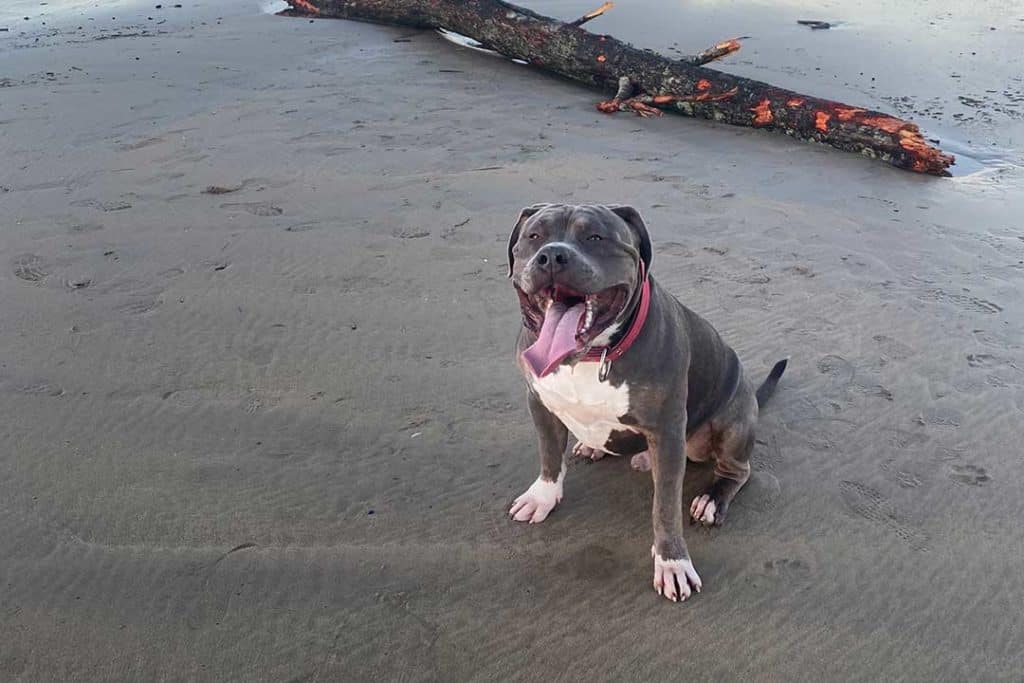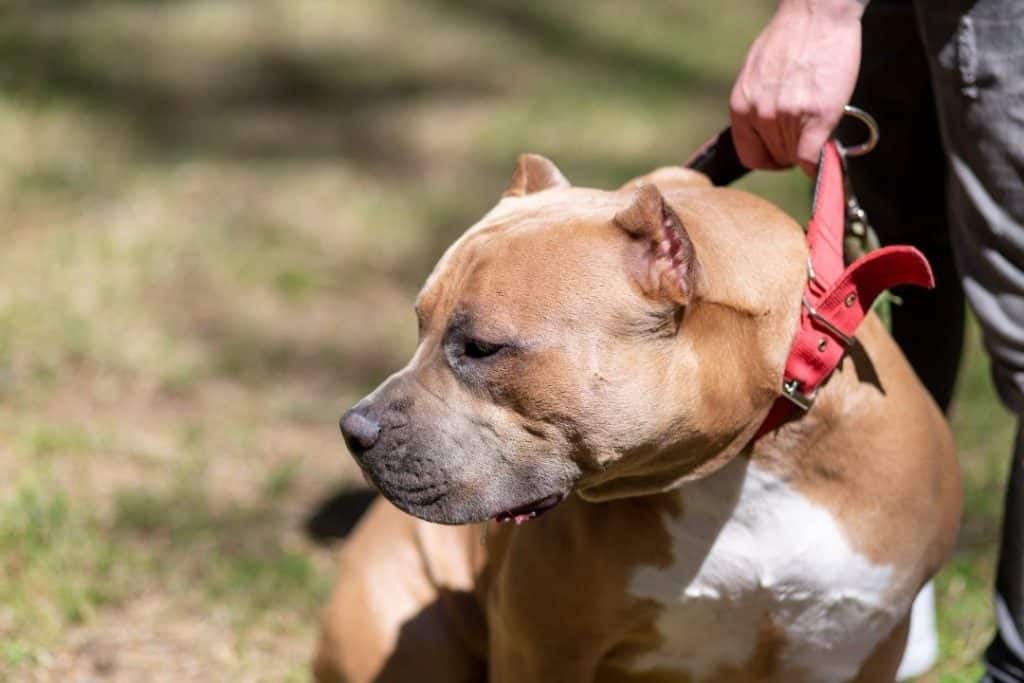This article may contain affiliate links, and I will be compensated if you make a purchase after clicking on my links (at no additional cost to you)
Dogs are prone to behavioral changes that may be a cause for worry. As an XL American Bully owner, I can’t express enough that knowing if something is wrong (like walking funny) with your Bully is crucial.
A funny walk could indicate a problem with your dog’s legs, back, or overall health.
You should seek medical attention for your Bully if you notice it walking funny and it does not improve in 2 to 3 days. An unusual gait (walk) could be a sign of illness or injury. Your veterinarian can determine the cause of the problem and provide the right course of treatment for your beloved canine.
Simply having a watchful eye could help you get a good idea of what might be going on. It will also help you pick out details useful for your veterinarian.
Read on to learn more about what you should pay attention to concerning your Bully’s peculiar walk and the possible treatments your vet will give to your dog.
Breaking Down Your Bully’s Unusual Gait
In dogs, a strange walk could be a limp of some kind. Limping is not uncommon in our canine friends: they sometimes get into situations that put them at risk of injury, given their playful and curious nature.
When you see that your Bully is limping, take note of the characteristics of the limp.
Notice How the Limp Began
One valuable source of information is recalling how the limping began to show. Was it gradual, or did it suddenly happen?
Gradual Limping May Indicate Health Issues
A gradual limp may barely be noticeable at first, but it becomes more pronounced as days progress. Gradual limping is usually a sign of an underlying condition that may be chronic or degenerative. Underlying causes of gradual limping have a better chance of being successfully treated if they’re diagnosed early enough.
Injury or Trauma Can Cause Sudden Limping
If your Bully’s limping began suddenly, it’s likely due to injury or trauma. Think back to any incidents that you think might have caused harm. On the other hand, it could be a result of something that happened without your knowledge.
Determine the Severity of the Limp
Severe limping is easier to spot since it’s more conspicuous. While it’s best to seek medical attention for even a minor limp, establishing how serious it is will help you decide how soon you should see your veterinarian.
Mild to Moderate Limping Still Require Proper Rest and Supervision
When your Bully’s limp is mild, it may still be using the affected leg. However, it’s important that your dog doesn’t put too much weight on the affected leg.
You can start by limiting your dog’s activity for a day or two and see if that helps resolve the situation. Discourage your Bully from doing any vigorous movement such as running and jumping by confining it to a small, comfortable designated area where it can relax. Keep your dog away from distractions, such as other people and pets.
With proper rest and supervision, a mild limp that isn’t so disruptive to your Bully’s regular life might improve in a few hours to a day. However, your best bet is to consult your veterinarian to rule out any possible illnesses that may be beginning to develop.
Severe Limping Requires Medical Attention As Soon as Possible
Severe limping may appear as a total reluctance to put weight on the affected limb. Your Bully may hold its leg up, preferring to move about as best as it can on the other three. This can cause extreme discomfort, and you should talk to your veterinarian immediately if your Bully’s limping is severe.
Check for Signs of Pain and Any Other Unusual Developments
A limp may be accompanied by other symptoms and changes in behavior, some of which could indicate that your bully is in pain.
Look out for these signs of discomfort:
- Over-grooming, like constantly licking a particular spot, it might be feeling pain in that area
- Vocalization, such as whining and yelping.
- Trembling
- Lack of interest in its usual activities, especially physical ones like running or playing.
- Aggression, especially when there previously was none, which is usually a sure sign of pain
- Sudden aversion to being petted or groomed
- Decrease in appetite
Make an appointment with your veterinarian if you notice any of these changes. Never give your Bully unprescribed medication for pain.
Get immediate medical assistance if you notice:
- Bleeding
- The affected limb is dangling or is at an unnatural angle
- Swelling on the affected limb
- Fever
- Vomiting
- Disorientation
- Difficulty in breathing
Identify Which Leg the Limp Is On
It’s easier to identify which limb is affected if your Bully’s limping is severe. In a milder case, or in a situation where more than one leg is concerned, it might not be so clear where the problem is.
Pay Attention to Your Bully’s Front Limbs
Your Bully will raise its head when the affected leg touches the ground. When your dog’s weight is on the good leg, it’ll lower its head back down. A more detectable sign of pain in a front limb is if your dog holds the affected leg up close to its body when it’s standing still or attempting to walk.
Look at How Your Bully Gets Back Up
When your bully is standing up, you’ll notice that it’ll try to gather itself using its front legs first, often with noticeable difficulty. Once it’s on its feet, it may place as much weight as possible on its front limbs, making it look like it’s leaning forward.
Possible Causes of Limping

Causes of limping vary greatly, but they can generally be broken down into injury-related causes and illness-related causes.
Injury-Related Causes
Injury-related limping usually comes up abruptly. A sudden limp could be caused by one or more of the following:
- Wounds, cuts, or bruises on paws or legs
- Broken or overgrown nails
- Embedded foreign material
- Injuries to the ligaments
- Muscle strain
- Bone fractures
Illness-Related Causes
Some illnesses affect the front legs, while others affect the back. Identifying which leg has the limp helps narrow down the possible cause of the limp.
Conditions That Affect the Front Legs
Illnesses that commonly affect the front legs include:
- Elbow dysplasia (developmental abnormality of the elbow joint)
- Osteochondritis dissecans (developmental bone disease)
- Shoulder instability
Conditions That Affect the Hind Legs
Other conditions are known to affect the hind legs. These include:
- Hip dysplasia (loosening of the hip joint)
- Cranial cruciate ligament rupture (torn knee ligament)
- Achilles tendon rupture (tearing of the Achilles tendon in the rear limb)
- Patellar luxation (knee dislocation)
It’s important to note that elbow dysplasia and hip dysplasia are common health concerns amongst American Bully breeds.
Conditions That Could Affect Any Leg
Other conditions could cause unusual gait, such as:
- Osteoarthritis
- Tick-borne diseases such as Lyme disease
- Spinal issues, which can cause difficulty in movement. For instance, intervertebral disc disease brings about a wobbly or ‘drunken’ kind of movement when walking
- Cancer
- Conditions affecting the nervous system
Treatment Options
Determining the cause of limping is always the first step in establishing the right course of treatment. Be prepared to give your veterinarian important information such as how long your bully has been walking unusually, an event you suspect might have triggered it, and what you have tried so far to help.
Some of the treatments that you can expect are:
- Pain relief and anti-inflammatory medication that is dog-safe
- Rest
- Antibiotics in the case of cuts and embedded foreign objects
- Bandages, splinters, and casts
- Chews. For joint health issues such as arthritis, your veterinarian may prescribe nutritional supplements such as these Glyde Mobility Chews from Chewy.com, which have pain-relieving and natural anti-inflammatory properties.
- Physical therapy
- Surgery
- Chemotherapy in the case of cancer
- Diet recommendations for weight management in case your Bully is overweight
Summary
Understanding your Bully is the first step in recognizing when something is amiss. In case of any worrying behavior changes, it’s always best to call your veterinarian right away. Don’t give your Bully any unprescribed medication.
Familiarize yourself with the situation at hand. Simple information such as how long your Bully has been walking differently and which limbs seem to be affected can be beneficial in narrowing down the cause of his unusual gait and getting him back in good health.

I created this blog to share my passion for bullies, and help current and future pitbull owners with things like diet and education.
Hope you find it useful, don’t hesitate to drop a comment on my articles!



